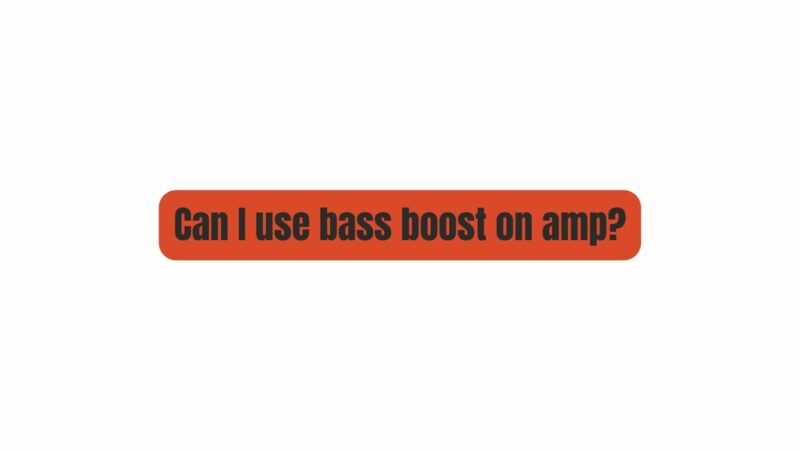The pursuit of the perfect bass tone has long been a fascination for musicians, audiophiles, and sound engineers alike. One tool that often comes into play when shaping bass sounds is the bass boost feature on amplifiers. In this article, we’ll dive into the world of bass boost, exploring what it is, how it functions, and whether it’s a useful tool for enhancing your audio experience.
Understanding Bass Boost
1. What Is Bass Boost?
Bass boost is a feature commonly found on amplifiers, audio receivers, headphones, and equalizers. It’s designed to emphasize or enhance the lower frequencies of an audio signal, primarily the bass frequencies, which are responsible for the deep and thumping sounds in music.
2. How Does Bass Boost Work?
The mechanics of bass boost vary depending on the device and technology used, but the general principle involves selectively amplifying specific frequency ranges within the bass spectrum. This amplification can be achieved through equalization, electronic circuits, or digital signal processing (DSP). Bass boost is usually adjustable, allowing users to control the extent of the bass enhancement.
Benefits of Using Bass Boost
Now, let’s delve into the advantages of using the bass boost feature:
1. Enhanced Bass Presence
The most obvious benefit of using bass boost is the augmentation of bass frequencies in your audio. This can add depth, impact, and richness to the music, making it more immersive, especially when listening to genres that rely heavily on bass, such as hip-hop, electronic dance music (EDM), or reggae.
2. Tailored Listening Experience
Bass boost allows you to customize your listening experience to match your preferences. If you’re a bass enthusiast, you can dial in extra low-end thump for a more satisfying and visceral listening experience. On the other hand, if you prefer a more balanced sound, you can adjust the bass boost to a subtler level or turn it off entirely.
3. Compensation for Audio Sources
Some audio sources, such as low-quality recordings or speakers, may lack bass presence. In such cases, bass boost can help compensate for deficiencies in the original audio signal, making it sound more enjoyable.
4. Overcoming Ambient Noise
When listening in noisy environments, such as on public transportation or in crowded spaces, bass boost can be a useful tool. The boosted bass frequencies can cut through ambient noise, ensuring that you still hear the fundamental elements of the music.
Drawbacks and Considerations
While bass boost offers several advantages, it’s important to be aware of its potential drawbacks and considerations:
1. Distortion and Muddiness
Excessive use of bass boost can lead to distortion and muddiness in the audio. This is particularly true if the original recording or equipment is not of high quality. Overemphasis on bass frequencies can mask other essential elements of the music and compromise overall clarity.
2. Room Acoustics
The acoustics of your listening environment can greatly impact the effectiveness of bass boost. In rooms with poor bass absorption and excessive reflections, boosting the bass may result in undesirable resonances and muddiness. Conversely, in acoustically treated rooms, the effects of bass boost may be more predictable and controlled.
3. Headphones vs. Speakers
The impact of bass boost can vary depending on whether you’re using headphones or speakers. In headphones, bass boost can create a more immersive and impactful listening experience. However, when using speakers, the interaction of bass frequencies with the room’s acoustics becomes a significant factor, potentially leading to unwanted resonances.
4. Music Genre
The suitability of bass boost also depends on the genre of music you’re listening to. While it may be ideal for bass-heavy genres like hip-hop or EDM, it may not be as desirable for genres that prioritize clarity and detail, such as classical or acoustic music.
Using Bass Boost Effectively
To make the most of the bass boost feature, here are some practical tips:
1. Start with a Neutral Setting
Begin with the bass boost control set to its neutral or zero position. This ensures that you’re listening to the audio as it was originally intended by the artist and recording engineer.
2. Use Moderation
When adjusting the bass boost, exercise moderation. Avoid cranking it to the maximum level immediately. Gradually increase the bass boost until you achieve the desired level of bass enhancement without introducing distortion or muddiness.
3. Experiment with Music
Try different levels of bass boost with a variety of music genres to determine when and how it complements your listening experience. What works well for one track or style may not be suitable for another.
4. Consider Your Listening Environment
Take into account the acoustics of your listening space. If you’re using speakers, consider room treatment options to manage any adverse effects of boosted bass.
5. High-Quality Audio Sources
Bass boost tends to work best with high-quality audio sources and well-produced recordings. If you’re listening to low-bitrate MP3 files or subpar recordings, excessive bass boost may not salvage the audio quality.
Conclusion
Bass boost is a versatile tool that can enhance your audio experience by adding depth and impact to bass frequencies. When used judiciously and in the right context, it can be a valuable asset for bass enthusiasts and those looking to customize their listening experience. However, it’s essential to exercise moderation and consider the quality of your audio source, room acoustics, and the music genre you’re listening to. Ultimately, bass boost, like any audio effect, should serve the goal of elevating your enjoyment of music without compromising clarity or fidelity.


